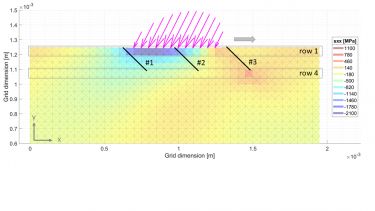Rail damage modelling - Modelling of crack growth and wear being subject to severe plastic deformation
Virtual Vehicle Research GmbH in partnership with The University of Sheffield is developing a numerical model to simulate fatigue crack initiation, growth and wear in severely shear-deformed steel, caused by wheel/rail contacts.

The contact between railway wheels and rails frequently leads to severe plastic deformation (SPD) of the material near the surface. This promotes rolling contact fatigue (RCF), fatigue crack growth (FCG) and wear. As SPD changes the microstructure, this leads to different FCG rates in specific directions of the material (anisotropy of FCG).
The aim of this project is to better understand these forms of degradation by means of a numerical model. With it, countermeasures can be developed in order to increase the service life of components and to reduce operating costs.
Therefore, an efficient discrete modelling approach is developed, which is capable of simulating multiple rolling contact cycles.
Due to the discrete character of the model, cracks can initiate autonomously and grow independently from each other. The cracks do not require either specific conditions for FCG or remeshing like finite element method (FEM) approaches. In the discrete model, the cracks develop in a natural way and proceed along the highest strained areas. This provides for the simulation of multiple cracks, crack branching and coalescence. Moreover, the anisotropy of FCG due to SPD is taken into account.
People
Markus Januschewsky, Virtual Vehicle Research GmbH
Gerald Trummer, Virtual Vehicle Research GmbH
Acknowledgement
This project has received funding from the Shift2Rail Joint Undertaking under the European Union’s Horizon 2020 research and innovation programme under grant agreement No 101012456. In Austria the project was also funded by the program “Mobilität der Zukunft” of the Austrian Federal Ministry for Climate Action (BMK) as well as by the Province Styria (Land Steiermark) and the Styrian Business Promotion Agency (SFG). Shift2Rail project IN2TRACK3.
The publication was written at Virtual Vehicle Research GmbH in Graz and partially funded within the COMET K2 Competence Centers for Excellent Technologies from the Austrian Federal Ministry for Climate Action (BMK), the Austrian Federal Ministry for Digital and Economic Affairs (BMDW), the Province of Styria (Dept. 12) and the Styrian Business Promotion Agency (SFG). The Austrian Research Promotion Agency (FFG) has been authorised for the programme management.
